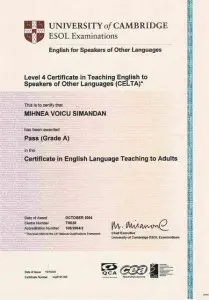The Cambridge Certificate in English Language Teaching to Adults (CELTA), offered by the University of Cambridge (ESOL Examinations), is run in over 120 centers around the world and it is considered by many authorities as the most important form of training in the TELF (Teaching English as a Foreign Language) industry. Between 30th of August and 24th of September 2004 I attended the Cambridge CELTA course at English and Computer College (ECC) from Bangkok.
Cambridge ESOL is a not-for-profit department of the University of Cambridge. It is part of the Cambridge Assessment Group, Europe’s largest assessment agency. Cambridge Assessment was established in 1858 as the University of Cambridge local Examinations Syndicate (UCLESS). Cambridge ESOL provides exams and tests covering a large range of subjects and levels with more than 8 million assessments taken every year in over 150 countries.
English and Computer College was established in 1990 and is the largest private language school from Thailand, with more than 50 branches spread all over the country. It runs a wide variety of courses from general conversation and grammar to specialized test preparation. It also provides pre-service and in-service teacher training programs for native and non-native speakers of English.
During the CELTA course that I attended, the trainers exposed the students (most of them teachers of English themselves) to the principles of effective teaching while the students acquired a range of practical skills for teaching English to adult learners. The course included theory sessions, teaching practice with real students, observation of experienced teachers and completion of a range of practically focused written assignments.
The present paper was built upon one of these assignments. It is a case study of a Thai young woman who was a student in my CELTA teaching practice lessons. The paper focuses on the learner in the learning context and identifies specific problems and recommends ways of dealing with the language problems that the interviewed student encountered. The paper ends with the rationale for the recommended activities and an overall conclusion.
2. Profile of the learner
The student I chose to observe and interview was Miss P.R. Her nickname is Nun, and she comes from Thailand. She was 24 years old at the time of the interview in 2004 and graduated from Busayarat Commercial School from Bangkok, with a degree in Computers in 1998. She had been studying English ever since primary school, when she was taught the basics of the English language. In high school, her English teachers focused mainly on vocabulary work, and during her university studies she had a few classes of English every week.
She had been studying English by herself and had taken different language courses intensively since 2003. She joined the CELTA English classes at English Computer College in Bangkok on the 30th of August 2004. She attended all the classes, joining her 15 classmates five times a week.
Miss P.R. had an outgoing personality. She was always willing to take part in the activities that the teachers prepared for the CELTA English lesson at ECC. The materials used by the teachers during the lessons varied, ranging from visual aids to worksheets, tape recorders, books, and game boards. Each lesson she took part in different writing, reading, listening, or speaking activities, but she also played fun games.
When asked, she said that she believed the focus of the English lessons was mainly on speaking skills. She considered the lessons at ECC relaxed, and the students had and wanted to have a lot of fun. She felt that the foreign teachers were friendly and that they all had interesting personalities, which were reflected in their teaching styles. She noticed that the teachers have different accents too. She confessed that some of the teachers talked too fast, and sometimes she had to translate or explain the activities to her classmates.
In her opinion, a good teacher should be kind and listen to all the students in the class. She would like teachers to pay more attention to the weak students and have in mind the fact that Thai students are shy and do not like to express their personal feelings. She thought it was a good idea for the teachers to “force them [the students] to speak” if they [the students] were reluctant to speak up in English.
One of the main reasons why she was so outspoken was the fact that she had the chance to speak English outside the classroom with other foreigners too. Her educational background and her motivation were also important factors that built up her confidence.
3. Specific problems
Her nationality was also important in her English learning context due to the fact that Thais have a specific mind set regarding languages. During my observations and interview I had noticed that she made frequent mistakes in pronunciation, grammar and vocabulary. Following are the most relevant examples:
a. Pronunciation
a.1. – confusion between /ʃ/ and /tʃ/ sounds
e.g.: “Thai people don’t show /tʃou/ their feelings.” – instead of /ʃou/
a.2. – confusion between /t/ and /θ/ sounds
e.g.: “You can say it both /bout/ ways.” – instead of /bouθ/
a.3. – dropping off the first consonant in a cluster, e.g. /sp/
e.g.: “I have to go to the hospital /’hɔpitl/.” – instead of /’hɔspitl /
b. Grammar
b.1. – misuse of prepositions
e.g.: “What is the difference about this and that?” – instead of ‘between’
b.2. – absence of articles
e.g.: “We play game.” – instead of “We play a / the game.”
b.3. – time inconsistency in ‘if clause’
e.g.: “If our society had a lot of people like this, I think we might be happier and our Earth be like heaven.” – instead of “If our society had a lot of people like this, I think we might be happier and our Earth would be like heaven.”
b.4 – lack of auxiliary verbs
e.g.: “I really excited with my first job.” – instead of “I was really excited with my first job.”
c. Vocabulary
c.1. – confusion between ‘nationality’ and ‘country’:
e.g.: “He is a Japan man.” – instead of “He is a Japanese man”
d. Speaking
d.1. – often usage of fillers
e.g.: “Teachers should like, a kind of, kind of force them to speak.”
4. Recommended activities
a. Pronunciation
a.1. – confusion between /ʃ/ and /tʃ/ sounds
– To raise the learners’ awareness of the /ʃ/ sound, the learner should try to hiss while pronouncing /ʃ/.
a.2. – confusion between /t/ and /θ/ sounds:
– To raise the learners’ awareness of the /θ/ sound, the learner should try to put his/her tongue out between the teeth while pronouncing /θ/.
a.3. – dropping off the first consonant in a cluster /sp/
– Divide the words that contain the /sp/ cluster in syllables, and then pronounce the word slowly, i.e. hos-pi-tal /’hɔs-pi-tl /.
b. Grammar
b.1. – misusage of prepositions
– Practice the use and form of prepositions in grammar exercises.
b.2. – absence of articles
– Practice the use and form of articles in grammar exercises.
b.3. – time inconsistency in ‘if clause’
– Practice the use and form of the ‘if clause’ in grammar exercises.
b.4 – lack of auxiliary verb
– Practice the use and form of auxiliary verbs in grammar exercises.
c. Vocabulary
c.1. – confusion between ‘nationality’ and ‘country’:
– Contrast the meaning of the two words using pictures:
d. Speaking
d.1. – often usage of filler
– Ring a bell every time the learner uses fillers.
5. Rationale for recommended activities
a. Pronunciation
a.1. – confusion between /ʃ/ and /tʃ/ sounds
– By exaggerating, the Thai learners would be able to remember how the /ʃ/ sound is pronounced in English (maybe thinking of the sound made by a snake).
a.2. – confusion between /t/ and /θ/ sounds
– By looking in the mirror, the learners would be able to visualize the way the /th/ sound is pronounced.
a.3. – dropping off the first consonant in a cluster /sp/
– To raise the learners’ awareness that the sound /sp/ actually exist in English. By seeing the letters separated, the learners will be able to visualize the fact that there is another letter to be pronounced in the word.
b. Grammar
b.1. – misusage of prepositions
– Demonstrate the meaning of the preposition using pictures.
b.2. absence of articles
– Identify the articles (‘a’, ‘an’ and ‘the’) in a text to understand the context they are used in.
b.3. – time inconsistency in ‘if clause’
– Identify the conditional clause 2 in a dialogue to understand the meaning and learn the pattern.
b.4 – lack of auxiliary verbs
– Understand the usage and form of ‘be’ as an auxiliary verb.
c. Vocabulary
c.1. – confusion between ‘nationality’ and ‘country’:
– The pictures clearly make the difference between Japan, a country, and the Japanese, people who come from Japan and are part of a specific culture.
d. Speaking
d.1. – often usage of filler
– The bell ringing makes the learner aware of the fact that he/she has used fillers again. He/she will try to censor himself/herself next time.
6. Conclusions
The leaner observed and interviewed made frequent mistakes in pronunciation, grammar, and vocabulary but these mistakes can be corrected using different teaching techniques.
References:
- Eastwood, John, (1992), Oxford Practice Grammar. Oxford University Press, Oxford.
- Martinet, A.V. and Thomson A.J., (1990), Oxford Pocket English Grammar. Oxford University Press, Oxford.
- Smyth, David, Thai speakers in Swan, Michael, (1987), Learner English, Cambridge University Press, Cambridge, pp. 252-263.
Online resources:
1. English and Computer College’s official website
2. Japanese woman clipart
3. Map of Japan image
4. University of Cambridge ESOL Examinations’ official website
Initially published in “Educatia PLUS” (pp. 68-74, n0. 7, 2008)



